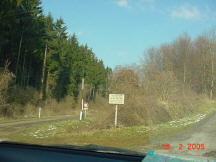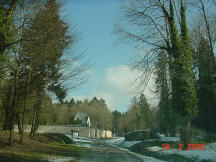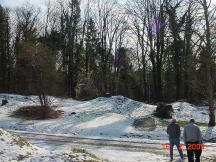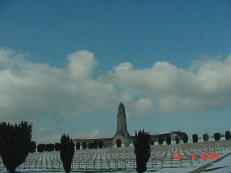This is a pictorial page and report of the trip to the Verdun, France area that my dad and I took while we were visiting Europe in February, 2005. We left Pfedelbach, Germany early on Feb. 16th for the 3.5 hour drive west to Verdun. Our distant German cousin, Peter Fromhold, drove us, as I navigated. We didn't have as much time as I would have liked, and upon arriving, we found that due to winter hours, most sights were closed until late afternoon. This included the Cafe, the Ossuaire, and the museum at Douamont. AS we had other sights to see that day, we couldn't stay around for their opening. I am hoping to return in 2007 or 2008 to try again.
What we did visit, was the area around Haumont. This village, destoyed at the begining of WWI, was located north of Verdun about 14km, in the hills above the Meuse. This area was mentioned in my grandfathers diary. Battery D moved to the area on 9 October, 1818. They shelled the German lines beyond Haumont, before moving on 19 October. They stayed there before pulling out and moving their battery to the Cunel Woods (The USA Military Cemetery is located near here.) This was where they were when the Armistice was signed 11 November, 1918.

Battery's from the 322nd were located on top of this hill, between the present community of Brabant-S-Meuse and the remains of the village of Haumont. Battery's D, E & F suffered the most casualties of the 322nd F.A., and most of these took place at this location, as well as the hill to the north-west (not in picture), both hills seperated by a road. This road lead to anotehr town that was destroyed during the war, called Malbrouk.

To the left and right of this fork, just below teh remains of the village of Haumont, are two hills, now covered in forest. Units from the 322nd were located here 9th to 13th October, prior to relocating to the position named above.

Village of Haumont- destroyed at begining of war. The chapel and wall that enclosed it were constructed about 1920. Notice the bunker along the right side of road, as the woods open up. The firing position of this bunker points towards the German lines.

Village of Haumont- note the large mounds. These are the rubble left from when the stuctures of the village were destroyed, now covered with almost ninety years of natural decay and vegatative matter. Pictured also are Peter Fromhold, and my dad, Raymond Fromholt(on right). According to signage at this sight, there were three reasons that the village was not re-built. A) The large quantity of explosives that lie buried in the ground, B) The pollution of springs from decaying bodies of men and horses buried in the ground, C) The risks inherent to land which has been subjucated to mustard gas attacks.

Ossuaire located by Douaumont. Contains the remains of 10,000 soldiers that died in the Verdun area. In foreground is the French National Military Cemetery.